Beatnik
Beatnik was a media stereotype prevalent throughout the late 1940s, 1950s to mid-1960s that displayed the more superficial aspects of the Beat Generation literary movement of the late 1940s and early to mid 1950s. Elements of the beatnik trope included pseudo-intellectualism, drug use, and a cartoonish depiction of real-life people along with the spiritual quest of Jack Kerouac's autobiographical fiction.
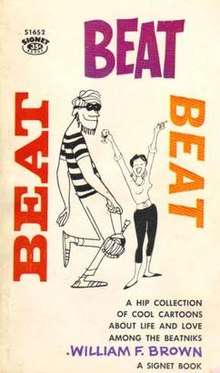
History
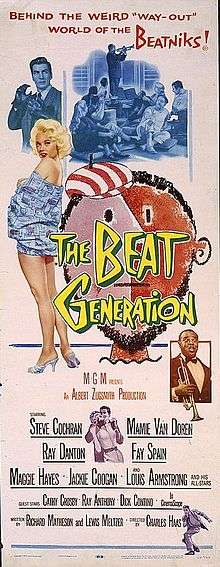
In 1948, Kerouac introduced the phrase "Beat Generation", generalizing from his social circle to characterize the underground, anticonformist youth gathering in New York at that time. The name came up in conversation with John Clellon Holmes, who published an early Beat Generation novel titled Go (1952), along with the manifesto This Is the Beat Generation in The New York Times Magazine.[1] In 1954, Nolan Miller published his third novel Why I Am So Beat (Putnam), detailing the weekend parties of four students.
"Beat" came from underworld slang—the world of hustlers, drug addicts and petty thieves, where Allen Ginsberg and Kerouac sought inspiration. "Beat" was slang for "beaten down" or downtrodden, but to Kerouac and Ginsberg, it also had a spiritual connotation as in "beatitude." Other adjectives discussed by Holmes and Kerouac were "found" and "furtive." Kerouac felt he had identified (and was the embodiment of) a new trend analogous to the influential Lost Generation.[2][3]
In "Aftermath: The Philosophy of the Beat Generation," Kerouac criticized what he saw as a distortion of his visionary, spiritual ideas:
The Beat Generation, that was a vision that we had, John Clellon Holmes and I, and Allen Ginsberg in an even wilder way, in the late Forties, of a generation of crazy, illuminated hipsters suddenly rising and roaming America, serious, bumming and hitchhiking everywhere, ragged, beatific, beautiful in an ugly graceful new way—a vision gleaned from the way we had heard the word "beat" spoken on street corners on Times Square and in the Village, in other cities in the downtown city night of postwar America—beat, meaning down and out but full of intense conviction. We'd even heard old 1910 Daddy Hipsters of the streets speak the word that way, with a melancholy sneer. It never meant juvenile delinquents, it meant characters of a special spirituality who didn't gang up but were solitary Bartlebies staring out the dead wall window of our civilization ...[4][5]
Kerouac explained what he meant by "beat" at a Brandeis Forum, "Is There A Beat Generation?", on November 8, 1958 at New York's Hunter College Playhouse. The seminar's panelists were Kerouac, James A. Wechsler, Princeton anthropologist Ashley Montagu and author Kingsley Amis. Wechsler, Montagu, and Amis wore suits, while Kerouac was clad in black jeans, ankle boots and a checkered shirt. Reading from a prepared text, Kerouac reflected on his beat beginnings:
It is because I am Beat, that is, I believe in beatitude and that God so loved the world that He gave His only begotten son to it ... Who knows, but that the universe is not one vast sea of compassion actually, the veritable holy honey, beneath all this show of personality and cruelty?[6]
Kerouac's statement was later published as "The Origins of the Beat Generation" (Playboy, June 1959). In that article, Kerouac noted how his original beatific philosophy had been ignored amid maneuvers by several pundits, among them San Francisco newspaper columnist Herb Caen, to alter Kerouac's concept with jokes and jargon:
I went one afternoon to the church of my childhood and had a vision of what I must have really meant with "Beat"... the vision of the word Beat as being to mean beatific ... People began to call themselves beatniks, beats, jazzniks, bopniks, bugniks, and finally I was called the "avatar" of all this.
In light of what he considered beat to mean and what beatnik had come to mean, Kerouac once observed to a reporter, "I'm not a beatnik, I'm a Catholic", showing the reporter a painting of Pope Paul VI and saying, "You know who painted that? Me."
Stereotype
.jpg)
In her memoir, Minor Characters, Joyce Johnson described how the stereotype was absorbed into American culture:
"Beat Generation" sold books, sold black turtleneck sweaters and bongos, berets and dark glasses, sold a way of life that seemed like dangerous fun—thus to be either condemned or imitated. Suburban couples could have beatnik parties on Saturday nights and drink too much and fondle each other's wives.[7]
Kerouac biographer Ann Charters noted that the term "Beat" was appropriated to become a Madison Avenue marketing tool:
The term caught on because it could mean anything. It could even be exploited in the affluent wake of the decade's extraordinary technological inventions. Almost immediately, for example, advertisements by "hip" record companies in New York used the idea of the Beat Generation to sell their new long playing vinyl records.[8]
Lee Streiff, an acquaintance of many members of the movement who went on to become one of its chroniclers, believed that the news media saddled the movement for the long term with a set of false images:
Reporters are not generally well versed in artistic movements, or the history of literature or art. And most are certain that their readers, or viewers, are of limited intellectual ability and must have things explained simply, in any case. Thus, the reporters in the media tried to relate something that was new to already preexisting frameworks and images that were only vaguely appropriate in their efforts to explain and simplify. With a variety of oversimplified and conventional formulas at their disposal, they fell back on the nearest stereotypical approximation of what the phenomenon resembled, as they saw it. And even worse, they did not see it clearly and completely at that. They got a quotation here and a photograph there — and it was their job to wrap it up in a comprehensible package — and if it seemed to violate the prevailing mandatory conformist doctrine, they would also be obliged to give it a negative spin as well. And in this, they were aided and abetted by the Poetic Establishment of the day. Thus, what came out in the media: from newspapers, magazines, TV, and the movies, was a product of the stereotypes of the 30s and 40s — though garbled — of a cross between a 1920s Greenwich Village bohemian artist and a Bop musician, whose visual image was completed by mixing in Daliesque paintings, a beret, a Vandyck beard, a turtleneck sweater, a pair of sandals, and set of bongo drums. A few authentic elements were added to the collective image: poets reading their poems, for example, but even this was made unintelligible by making all of the poets speak in some kind of phony Bop idiom. The consequence is, that even though we may know now that these images do not accurately reflect the reality of the Beat movement, we still subconsciously look for them when we look back to the 50s. We have not even yet completely escaped the visual imagery that has been so insistently forced upon us.[9]
Etymology
The word "beatnik" was coined by Herb Caen in his column in the San Francisco Chronicle on April 2, 1958. Caen wrote "Look magazine, preparing a picture spread on S.F.'s Beat Generation (oh, no, not AGAIN!), hosted a party in a No. Beach house for 50 Beatniks, and by the time word got around the sour grapevine, over 250 bearded cats and kits were on hand, slopping up Mike Cowles' free booze. They're only Beat, y'know, when it comes to work ..."[10] Caen coined the term by adding the Yiddish suffix -nik to the Beat Generation.
Caen's column with the word came six months after the launch of Sputnik I.[11][12] Objecting to the term, Allen Ginsberg wrote to the New York Times to deplore "the foul word beatnik", commenting, "If beatniks and not illuminated Beat poets overrun this country, they will have been created not by Kerouac but by industries of mass communication which continue to brainwash man."[13]
Beat culture
In the vernacular of the period, "Beat" referred to Beat culture, attitude and literature; while "beatnik" referred to a stereotype found in cartoon drawings and (in some cases at worst) twisted, sometimes violent media characters. In 1995, film scholar Ray Carney wrote about the authentic beat attitude as differentiated from stereotypical media portrayals of the beatnik:
Much of Beat culture represented a negative stance rather than a positive one. It was animated more by a vague feeling of cultural and emotional displacement, dissatisfaction, and yearning, than by a specific purpose or program ... It was many different, conflicting, shifting states of mind.[14]
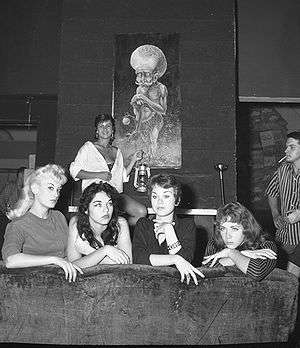
Since 1958, the terms Beat Generation and Beat have been used to describe the antimaterialistic literary movement that began with Kerouac in the 1940s and continued into the 1960s. The Beat philosophy of antimaterialism and soul searching influenced 1960s musicians such as Bob Dylan, the early Pink Floyd and The Beatles.
However, the soundtrack of the beat movement was the modern jazz pioneered by saxophonist Charlie Parker and trumpeter Dizzy Gillespie, which the media dubbed bebop. Jack Kerouac and Allen Ginsberg spent much of their time in New York jazz clubs such as the Royal Roost, Minton's Playhouse, Birdland and the Open Door, shooting the breeze and digging the music. Charlie Parker, Dizzy Gillespie and Miles Davis rapidly became what Ginsberg dubbed "secret heroes" to this group of aesthetes. The Beat authors borrowed much from the jazz/hipster slang of the 1940s, peppering their works with words such as "square", "cats", "cool" and "dig".
At the time the term "beatnik" was coined, a trend existed among young college students to adopt the stereotype. Men emulated the trademark look of bebop trumpeter Dizzy Gillespie by wearing goatees, horn-rimmed glasses and berets, rolling their own cigarettes, and playing bongos. Fashions for women included black leotards and long, straight, unadorned hair, in a rebellion against the middle-class culture of beauty salons. Marijuana use was associated with the subculture, and during the 1950s, Aldous Huxley's The Doors of Perception further influenced views on drugs.
By 1960, a small "beatnik" group in Newquay, Cornwall, England (including a young Wizz Jones) had attracted the attention and abhorrence of their neighbours for growing their hair beyond shoulder length, resulting in a television interview with Alan Whicker on BBC television's Tonight series.[16]
The Beat philosophy was generally countercultural and antimaterialistic, and stressed the importance of bettering one's inner self over material possessions. Some Beat writers, such as Alan Watts, began to delve into Eastern religions such as Buddhism and Taoism. Politics tended to be liberal, left-wing and anti-war, with support for causes such as desegregation (although many of the figures associated with the original Beat movement, particularly Kerouac, embraced libertarian and conservative ideas). An openness to African American culture and arts was apparent in literature and music, notably jazz. While Caen and other writers implied a connection with communism, no obvious or direct connection occurred between Beat philosophy, as expressed by the literary movement's leading authors, and that of the communist movement, other than the antipathy both philosophies shared towards capitalism. Those with only a superficial familiarity with the Beat movement often saw this similarity and assumed the two movements had more in common.
The Beat movement introduced Asian religions to Western society. These religions provided the Beat generation with new views of the world and corresponded with its desire to rebel against conservative middle-class values of the 1950s, old post-1930s radicalism, mainstream culture, and institutional religions in America.[17]
By 1958, many Beat writers published writings on Buddhism. This was the year Jack Kerouac published his novel The Dharma Bums, whose central character (whom Kerouac based on himself) sought Buddhist contexts for events in his life.
Allen Ginsberg's spiritual journey to India in 1963 also influenced the Beat movement. After studying religious texts alongside monks, Ginsburg deduced that what linked the function of poetry to Asian religions was their mutual goal of achieving ultimate truth. His discovery of Hindu mantra chants, a form of oral delivery, subsequently influenced Beat poetry. Beat pioneers who followed a Buddhism-influenced spiritual path appreciated Asian religion's profound understanding of human nature and insights into the being, existence and reality of mankind.[17] Many of the Beat advocates believed that the core concepts of Asia religious philosophies had the means of elevating American society's consciousness, and these concepts informed their main ideologies.[18]
Notable Beat writers such as Kerouac, Ginsberg, and Gary Snyder were drawn to Buddhism to the extent that they each, at different periods in their lives, followed a spiritual path in their quests to provide answers to universal questions and concepts. As a result, the Beat philosophy stressed the bettering of the inner self and the rejection of materialism, and postulated that East Asian religions could fill a religious and spiritual void in the lives of many Americans.[17]
Many scholars speculate that Beat writers wrote about Eastern religions to encourage young people to practice spiritual and sociopolitical action. Progressive concepts from these religions, particularly those regarding personal freedom, influenced youth culture to challenge capitalist domination, break their generation's dogmas, and reject traditional gender and racial rules.[18]
Beatniks art
Beatniks art is the direction of contemporary art that originated in the United States as part of the beatniks movement in the 1960s.[19] The movement itself, unlike the so-called "lost generation" did not set itself the task of changing society, but tried to distance itself from it, while at the same time trying to create its own counter-culture. The art created by artists was influenced by jazz, drugs, occultism, and other attributes of beatniks movement.[19]
The scope of the activity was concentrated in the cultural circles of New York, Los Angeles, San Francisco and North Carolina. Prominent representatives of the trend were artists: Wallace Berman, Jay DeFeo, Jess Collins, Robert Frank, Claes Oldenburg and Larry Rivers.
The culture of the beatniks generation has become a kind of intersection for representatives of the creative intellectual of the United States associated with visual and visual art, which are usually attributed to other areas and trends of artistic expression, such as assemblage, happening, funk art and neo-dadaism. They made efforts to destroy the wall between art and real life, so that art would become a living experience in cafes or jazz clubs, and not remain the prerogative of galleries and museums. Many works of artists of the direction were created on the verge of various types of art.[20]
Artists wrote poetry and poets painted, something like this can describe the processes taking place within the framework of the movement. Performances were a key element in the art of beats, whether it was the Theatrical Event of 1952 at Black Mountain College or Jack Kerouac typing in 1951 the novel “On the Road” on a typewriter in a single session on a single roll of 31 meter long paper.[19]
Representatives of the movement were united by hostility to traditional culture with its conformism and brightly degenerate commercial component. They also did not like the approach of traditional culture to hushing up the dark side of American life - violence, corruption, social inequality, racism. They tried through art to create a new way of life based on the ideals of rebellion and freedom.[19]
Critics highlight the artist Wallace Berman as the main representative of the direction. In his work concentrated many of the characteristic features of hipsters, especially in his collages made on photocopied photographs, which are a mixture of elements of pop art and mysticism. Among other artists and works, one can single out the work "The Rose" by the artist Jay DeFeo, the work on which was carried out for seven years, a huge painting-assembly weighing about a ton with a width of up to 20 centimeters.[21]
Beatniks in media
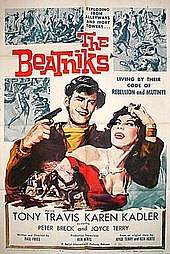
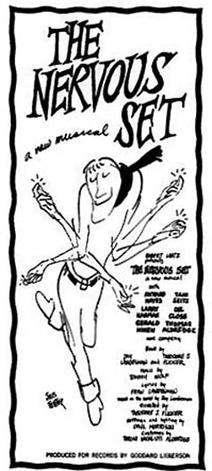
- Possibly the first movie portrayal of the Beat society was in the 1950 film D.O.A, directed by Rudolph Maté. In the film the main character goes to a loud San Francisco bar, where one woman shouts to the musicians: "Cool! Cool! Really cool!" One of the characters says, "Man, am I really hip", and another replies, "You're from nowhere, nowhere!". Lone dancers are seen moving to the beat. Some are dressed with accessories and have hairstyles that one would expect to see in much later films. Typical 1940s attire is mixed with beatnik clothing styles, particularly in one male who has a beatnik hat, long hair, and a mustache and goatee, but is still wearing a dress suit. The bartender refers to a patron as "Jive Crazy" and talks of the music driving its followers crazy. He then tells one man to "Calm down Jack!" and the man replies, "Oh don't bother me, man. I'm being enlightened!". The scene also demonstrates the connection to and influence of 1940s genres of African American music such as Bebop on the emergence of Beat culture. The featured band "Jive" is all-black, while the customers who express their appreciation for the music in a jargon that would come to characterize the stereotype of Beat culture are young white hipsters.
- The 1953 Dalton Trumbo movie Roman Holiday starring Audrey Hepburn and Gregory Peck features a supporting character played by Eddie Albert that is a stereotypical beatnik, appearing five years before the term was coined.[22] He has an Eastern European surname, Radovich, and is a promiscuous photographer who wears baggy clothes, a striped T-shirt and a beard, which is mentioned four times in the screenplay.[23]
- The 1954 movie White Christmas features a beatnik themed dance number called "Choreography."
- Stanley Donen brought the theme to the film musical in Funny Face (1957) with one Audrey Hepburn production number revamped into a Gap commercial in 2006. One of Jerry Yulsman's photographs of Kerouac was altered for use in a Gap print ad, in which Joyce Johnson was omitted from the image.
- The 1957 monster movie The Undead features ghosts performing a beatnik dance in a graveyard.
- The 1958 film Bell Book and Candle is a romantic comedy about beatnik witches living in Greenwich Village, NYC.
- Another film involving beatnik culture is Roger Corman's 1959 black comedy A Bucket of Blood, written by Charles B. Griffith. In the film, a coffee house busboy longs for acceptance by the beatnik patrons, so he develops a style of sculpture using dead animals and people. An influential character in the film is the beatnik poet, who convinces the group to accept the busboy as a significant artist. Indicating his acceptance into the group, an adoring female fan surreptitiously gives the artist a vial of heroin, implying that drug use was an accepted, and perhaps required, part of beatnik culture. The film's soundtrack is cool, horn-based jazz. There is also a performance by a singer with an acoustic guitar. Rock & roll music is absent, despite its popularity and counter-cultural aspect. One possibility is that the upbeat feel of rock & roll music was at odds with the detached, low-key, nihilistic attitude of the beat society.
- The character Maynard G. Krebs, played on TV by Bob Denver in The Many Loves of Dobie Gillis (1959–63), solidified the stereotype of the indolent non-conformist beatnik, which contrasted with the aggressively rebellious Beat-related images presented by popular film actors of the early and mid-1950s, notably Marlon Brando and James Dean.
- The subculture surfaced on Broadway as musical comedy in The Nervous Set (1959) by Neurotica editor Jay Landesman and Theodore J. Flicker with music by Tommy Wolf and lyrics by Fran Landesman; this was the source of two jazz standards, "Spring Can Really Hang You Up the Most" and "The Ballad of the Sad Young Men" (recorded by Gil Evans, Anita O'Day, Mark Murphy (singer), Roberta Flack, Petula Clark, Rod McKuen, Shirley Bassey and others). The show opened with the song, "Man, We're Beat".
- The Beat Generation (1959) made an association of the movement with crime and violence, as did The Beatniks (1960). The notion of violence or other criminality possibly arose because hardcore outlaws and criminals were popularly portrayed as using many of the same jive terms in their speech, and this distortion could also be seen in popular TV shows with regard to the contemporary greasers as well as the hippies a few years later.
- The 1960 Jerry Lewis film Visit to a Small Planet, based on a satirical Gore Vidal play, features Lewis as an alien who entrances beatniks at a nightclub ("We don't use floors... we use fog") and who appears to understand a scat song as being in an intelligible language.
- The film The Rebel (US: Call Me Genius, 1961) featuring British comedian Tony Hancock's tells of a London office clerk who moves to Paris to pursue his vocation as an artist of the Beat Generation; the film satirizes pseudointellectuals.
- Two for the Seesaw was a successful Broadway play by William Gibson and was made into a 1962 film which portrayed the fated romance between a small town square (Jerry) and Greenwich Village beatnik chick (Gittel). Jerry is perplexed by what he perceives as Gittel's chaotic and promiscuous lifestyle and goes back to his wife in hicksville.
- The Looney Tunes cartoon character Cool Cat is often portrayed as a beatnik, as is the banty rooster in the 1963 Foghorn Leghorn short Banty Raids.
- Similarly, the Beany and Cecil cartoon series also had a beatnik character, Go Man Van Gogh (aka "The Wildman"), who often lives in the jungle and paints various pictures and backgrounds to fool his enemies, first appearing in the episode, "The Wildman of Wildsville."
- Hanna Barbera's series Top Cat features Spook, a beatnik cat; and their series Scooby-Doo, features a beatnik character Shaggy.
- In the animated series The Simpsons, the parents of character Ned Flanders are beatniks.
- In the animated television series Doug, Doug's older sister, Judy Funnie, is characterized as a beatnik.
- Two beatniks (played by Ric Ocasek of The Cars and Pia Zadora) painted furiously and played bongos in John Waters' 1988 Hairspray.
- The long-running midnight movie series Off Beat Cinema, which debuted in 1993, is hosted by a trio of coffee-drinking beatniks.
- In the 1999 animated film The Iron Giant the character Dean McCoppin (voiced by Harry Connick Jr.) is portrayed as a sympathetic beatnik, whose passion is turning discarded items in his junkyard into sculptures.
- In the Beavis and Butt-head episode "Buttniks," the two giggling, slacker teens find themselves in a beatnik coffee house where Beavis gets buzzed on cappuccinos. The character Daria, from Beavis and Butt-head and its spin-off Daria, may be a beatnik.
- In the Girl Meets World episode "Girl Meets 1961" four of the main characters discover their ancestors attended a beatnik café in Greenwich Village named Café Hey.
- Beat coffeehouses are depicted in So I Married an Axe Murderer (1993), American Pop (1981), Take Her, She's Mine (1964), The Flower Drum Song (1961), The Hudsucker Proxy (1994), An Extremely Goofy Movie (2000) and episode six, "Babylon", of Mad Men.
- Two Beatnik-related films were riffed on the cult TV series Mystery Science Theater 3000: The aforementioned 1960's The Beatniks and 1959's The Rebel Set[24][25]
Beatnik books
Alan Bisbort's survey, Beatniks: A Guide to an American Subculture, was published by Greenwood Press in 2009 as part of the Greenwood Press Guides to Subcultures and Countercultures series. The book includes a timeline, a glossary and biographical sketches. Others in the Greenwood series: Punks, Hippies, Goths and Flappers.[26]
Tales of Beatnik Glory: Volumes I and II, by Ed Sanders, is, as its name suggests, a collection of short stories, and a definitive introduction to the beatnik scene as lived by its participants.[27] The author, who went on to found the Fugs, lived in the beatnik epicenter of Greenwich Village and the Lower East Side in the late 1950s and early 1960s.
Among the humor books, Beat, Beat, Beat was a 1959 Signet paperback of cartoons by Phi Beta Kappa Princeton graduate William F. Brown, who looked down on the movement from his position in the TV department of the Batten, Barton, Durstine & Osborn advertising agency.[28]
Suzuki Beane (1961), by Sandra Scoppettone with Louise Fitzhugh illustrations, was a Bleecker Street beatnik spoof of Kay Thompson's Eloise series (1956–59).
In the 1960s, the comic book Justice League of America's sidekick Snapper Carr was also portrayed as a stereotypical beatnik, down to his lingo and clothes. The DC Comics character Jonny Double is also portrayed as a beatnik.
Museums
In San Francisco, Jerry and Estelle Cimino operate their Beat Museum, which began in 2003 in Monterey, California and moved to San Francisco in 2006.[29]
Ed "Big Daddy" Roth used fiberglass to build his Beatnik Bandit in 1960. Today, this car is in the National Automobile Museum in Reno, Nevada.[30]
See also
- Beatniks art
- Cool (aesthetic)
- Moody Street Irregulars
- Stilyagi, the Russian equivalent
- Subcultures of the 1950s
- Yves Saint Laurent (designer)
References
- ""This is the Beat Generation" by John Clellon Holmes". Literary Kicks. July 24, 1994. Archived from the original on November 22, 2011.
- Kerouac, Jack. The Portable Kerouac. Ed. Ann Charters. Penguin Classics, 2007.
- Holmes, John Clellon. Passionate Opinions: The Cultural Essays (Selected Essays By John Clellon Holmes, Vol 3). University of Arkansas Press, 1988. ISBN 1-55728-049-5
- "Jack Kerouac (1922-1969) Poems, Terebess Asia Online (TAO)". Terebess.hu. Archived from the original on July 22, 2009.
- Reviews: On the Road Archived 2010-06-29 at the Wayback Machine
- "F:\column22.html". Blacklistedjournalist.com. Archived from the original on January 2, 2011.
- Johnson, Joyce. Minor Characters, Houghton Mifflin, 1987.
- Charters, Ann. Beat Down to Your Soul: What Was the Beat Generation? Penguin, 1991.
- Streiff, Thornton Lee. Introduction to Web site chronicling the Beat scene in Wichita, Kansas. Web.archive.org
- Caen, Herb (February 6, 1997). "Pocketful of Notes". SFGate.com. Archived from the original on January 28, 2011.
- Hamlin, Jesse (November 26, 1995). "How Herb Caen Named a Generation". San Francisco Chronicle. Archived from the original on August 8, 2014.
- Dickson, Paul (2009). Sputnik: The Shock of the Century. Bloomsbury Publishing. p. 251. ISBN 9780802718044.
- Ginsberg, Allen; Morgan, Bill (September 2, 2008). "The Letters of Allen Ginsberg". Hachette Books – via Google Books.
- "Media Resources Center | UC Berkeley Library". Lib.berkeley.edu. Archived from the original on September 6, 2006.
- Los Angeles Times, August 27, 1959
- "Beatniks in Newquay, 1960". Archived from the original on November 18, 2015 – via www.youtube.com.
- Carl Jackson. "The Counterculture Looks East: Beat Writers and Asian religion". American Studies, Vol. 29, No. 1 (spring 1988).
- Chandarlapaty, Ray (2009). "Part 3: Jack Kerouac, the Common "Human Story" and White-Other Historicity: Beatniks Face the Challenge of Popularizing and Humanizing Otherness". The Beat Generation and Counterculture: Paul Bowles, William S. Burroughs, Jack Kerouac. p. 103 (of 180). ISBN 1433106035.
- Dempsey, Amy (2010). Styles, Schools and Movements: The Essential Encyclopaedic Guide to Modern Art. Thames & Hudson. ISBN 9780500288443.
- Ferguson, Russell; Calif.), Museum of Contemporary Art (Los Angeles (1999-01-01). In Memory of My Feelings: Frank O'Hara and American Art. University of California Press. ISBN 9780520222434.
- "Весомое замечание: самая монументальная в мире картина маслом от Jay DeFeo". Kulturologia.ru. Retrieved 2019-09-19.
- "January 20th, 2014: Roman Holiday (1953)". Leagueofdeadfilms.com. 20 January 2014. Archived from the original on 28 April 2018. Retrieved 28 April 2018.
- "Roman Holiday Script - Screenplay from the Audrey Hepburn movie". Script-o-rama.com. Archived from the original on 20 October 2017. Retrieved 28 April 2018.
- MST3K: "The Rebel Set" on IMDb
- MST3K: "The Beatniks" on IMDb
- "Beatniks: How I Wrote A Subculture Guidebook". Literary Kicks. April 7, 2010. Archived from the original on December 30, 2010.
- Sanders, Ed (1990). Tales of Beatnik Glory: Volumes I and II. New York: Citadel Underground. ISBN 978-0-8065-1172-6.
- Brown, William F. Beat, Beat, Beat. New American Library|Signet, 1959.
- "The Beat Museum - 540 Broadway, San Francisco. Open Daily 10am-7pm". Thebeatmuseum.org. Archived from the original on 20 February 2012. Retrieved 28 April 2018.
- "Beatnik Bandit - Milestones - Street Rodder Magazine". Streetrodderweb.com. 30 June 2005. Archived from the original on 13 April 2012. Retrieved 28 April 2018.
Sources
- Charters, Ann (ed.). The Portable Beat Reader. Penguin Books. New York. 1992. ISBN 0-670-83885-3 (hc); ISBN 0-14-015102-8 (pbk)
- Nash, Catherine. "The Beat Generation and American Culture." (PDF file)
- Phillips, Lisa (ed). Beat Culture and the New America: 1950-1965. New York: Whitney Museum of Art and Paris: Flammarion, 1995.
External links
| Look up beatnik in Wiktionary, the free dictionary. |